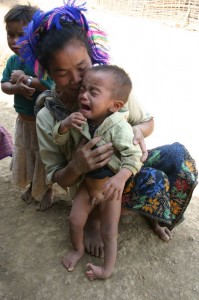Project Phongsali: For children with club foot getting timely treatment is critical.

Pome, about 14 months old, is learning to walk but because of his birth defect he's been walking on his ankle bone. His family had no idea that his condition could be treated. WHWV will see that he gets proper treatment.
Day 30
Today we had to make a market run to Muang May for fresh vegetables. Pickings are really slim in Sop Houn. About the only surplus items people here have to sell are live chickens, rice, chili peppers, onions and garlic. I’m surprised that we can’t even find bananas in the village.
The market in Muang May looked pretty bare as we passed through ten days ago, but now we view it as our Walmart. There’s a Chinese-owned stall selling all kinds of electronics and hardware, and the food market has bananas, oranges, lettuce, green beans, cabbage, tomatoes, and a wide assortment of DGLV: dark green leafy vegetables (of unknown type and origin). Most days there is dried beef and buffalo skin; some days, fresh meats.
While in Muang May, we stopped by the district hospital to see if they had any UXO-accident victims with stories to tell. They didn’t, but somehow the topic of child amputees came up, and that led to the topic of children with birth defects.
An hour later, we had somehow been roped into driving a nurse from the hospital over 20 kilometers of one-lane mountain road to check on a child she was worried about, a young boy with club foot who has never had treatment. The nurse was concerned that she somehow must find help for the boy soon, while there is still a chance for remediation of the birth defect.
Along the way, the nurse told me that the last time she was in the boy’s village was the time she made the 40-kilometer roundtrip journey on foot, stopping to see patients in several other villages along the way.
As soon as my eyes fell on the boy, I was glad that we’d made the trip. The little guy, Pome, is about 15 months old, eager to walk but struggling. His left foot is turned in at such a sharp angle that he has been walking on the side of his foot, as evidenced by a dark callus forming on the ball of his ankle.
When we arrived, the boy’s mother was out working in the rice fields, and Pome was in his grandmother’s arms. The grandmother was positive that her daughter would do whatever she could to help her son, but she said the family no idea what kind of treatment to seek: medicine? surgery? And of course, they had no means to pay for either treatment or a journey to a place offering help. (Since the nurse had just learned from me about treatment options at the National Rehabilitation Center, it’s no surprise that the grandmother was also in the dark).
Fearful that we might not get off the mountain road before dark, we had to leave the village before Pome’s mother returned home from the fields. But the boy’s grandmother was so confident that her daughter would agree to any plan, we talked all the way home about various ways we might get the boy to treatment, either at the National Rehab Center in Vientiane or at one of the COPE (Cooperative Orthotics and Prosthetic Enterprise) centers in northern Laos.
If Pome proves to be a good candidate for the procedure that I’ve seen successfully used before, he’ll have his foot slightly rotated and a firm plaster cast put on to hold it in that new position. Then, a week later, the cast will be removed, the foot rotated a bit more, and a new cast applied to hold the new position. Over a span of six weeks or more, with multiple castings, the boy’s foot will slowly be worked into a natural position, enabling him to walk normally throughout the rest of his life.
It is gratifying to be witness to a young life at a crossroads, and then to play some small part in getting the individual on the right path. Yai and I have worked up a budget. We figure that for less than $150 we can hire someone trustworthy to take the boy and his mother to treatment. That sum will permit our organization to pay the guide a modest wage, and pick up the cost of food, lodging, and bus fares for the three-day trip from the distant village to a treatment center. We’re now searching for a Khamu-speaking chaperone.
Time is critical. The more the toddler uses that foot in the wrong position, the less likely that any therapy will succeed. In addition, the rainy season is coming. Once the rains begin, every adult in Pome’s village will be planting rice and then tending their vegetable gardens. It’s likely that Pome’s mother cannot be spared during planting time (nourishment for all being more critical than mobility for one). And with the rains, the road to Pome’s village will become impassible. The nurse who led us to there said that every year, the village becomes isolated for months at a time.
